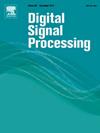A residue-based robust adaptive beamforming with flexible null management
IF 2.9
3区 工程技术
Q2 ENGINEERING, ELECTRICAL & ELECTRONIC
引用次数: 0
Abstract
Steering vector errors and interference nonstationarity are two main degrading factors of adaptive beamforming methods. The former can be mitigated by using the interference-plus-noise covariance matrix (INCM), instead of sample covariance matrix. An estimate of INCM can be obtained through the integration of the Capon spectrum, which usually approximated by a summation over a uniform grid points on the angular region of interference and noise. A simple technique to overcome the nonstationarity problem is the null widening technique using covariance matrix tapers (CMT). The first purpose of this paper is to introduce a gridless method to do the integration for calculating the INCM. The method, applicable for uniform linear arrays, applies the residue theorem to calculate the integral through converting it into an integral over a closed contour. The second purpose is to modify the beamformer such that each null can separately be widened and deepened to definitely mitigate the corresponding interference. This purpose is also attainable by the residue-based representation of INCM, which separates the contribution of each interference, based on which a flexible null widening and deepening technique is introduced by applying different CMTs on different contributions and by moving the corresponding singular point toward the unit circle.
求助全文
约1分钟内获得全文
求助全文
来源期刊

Digital Signal Processing
工程技术-工程:电子与电气
CiteScore
5.30
自引率
17.20%
发文量
435
审稿时长
66 days
期刊介绍:
Digital Signal Processing: A Review Journal is one of the oldest and most established journals in the field of signal processing yet it aims to be the most innovative. The Journal invites top quality research articles at the frontiers of research in all aspects of signal processing. Our objective is to provide a platform for the publication of ground-breaking research in signal processing with both academic and industrial appeal.
The journal has a special emphasis on statistical signal processing methodology such as Bayesian signal processing, and encourages articles on emerging applications of signal processing such as:
• big data• machine learning• internet of things• information security• systems biology and computational biology,• financial time series analysis,• autonomous vehicles,• quantum computing,• neuromorphic engineering,• human-computer interaction and intelligent user interfaces,• environmental signal processing,• geophysical signal processing including seismic signal processing,• chemioinformatics and bioinformatics,• audio, visual and performance arts,• disaster management and prevention,• renewable energy,
 求助内容:
求助内容: 应助结果提醒方式:
应助结果提醒方式:


